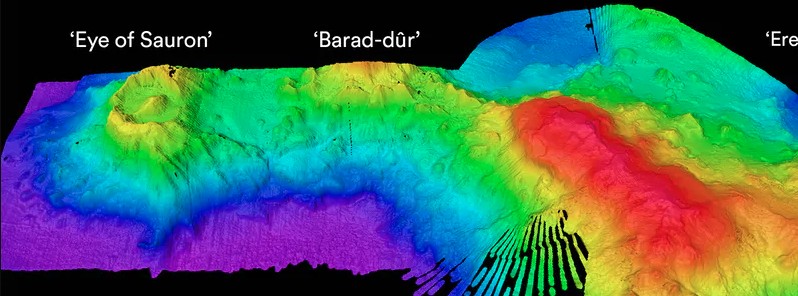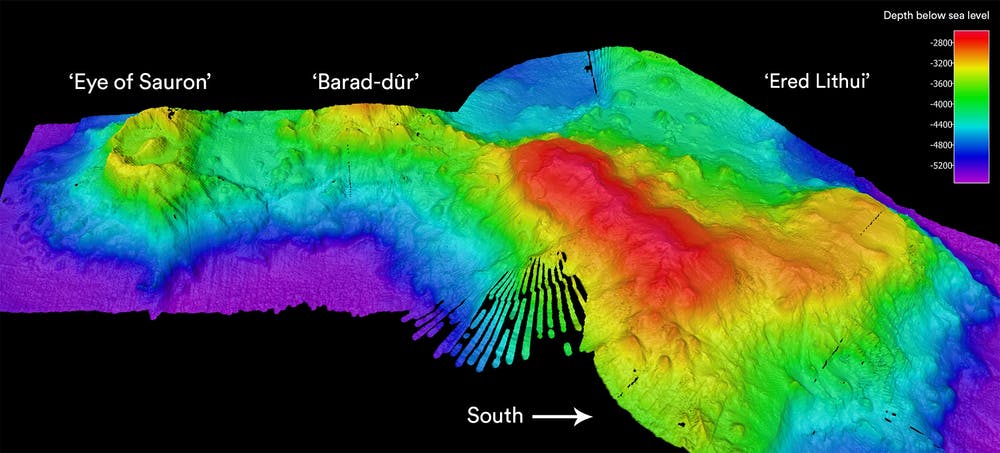Newly discovered undersea volcano near Christmas Island looks like the Eye of Sauron

An ancient undersea volcano was discovered 280 km (175 miles) southeast of the Christmas Islands. The volcano was discovered by CSIRO’s dedicated ocean research vessel, the RV Investigator.
"Previously unknown and unimagined, this volcano emerged from our screens as a giant oval-shaped depression called a caldera, 6.2 km [3.8 miles] by 4.8 km [3 miles] across. It is surrounded by a 300 m [985 feet] high rim (resembling Sauron’s eyelids), and has a 300 m high cone-shaped peak at its center (the 'pupil')," Tim O'Hara, Senior Curator of Marine Invertebrates at the Museums Victoria, wrote for The Conversation.
Further mapping to the south revealed a smaller sea mountain covered in numerous volcanic cones, and further still to the south was a larger, flat-topped seamount.
"Following our Lord of the Rings theme, we have nicknamed them Barad-dûr ('Dark Fortress') and Ered Lithui ('Ash Mountains'), respectively," O'Hara said.
Although author J.R.R. Tolkein’s knowledge of mountain geology wasn’t perfect, O'Hara said their names are wonderfully appropriate given the jagged nature of the first and the pumice-covered surface of the second.
The Eye of Sauron, Barad-dûr, and Ered Lithui are part of the Karma cluster of seamounts that have been previously estimated by geologists to be more than 100 million years old, and which formed next to an ancient sea ridge from a time when Australia was situated much further south, near Antarctica.

Sonar image of the ‘Eye of Sauron’ volcano and nearby seamounts on the sea bed south-west of Christmas Island. Credit: Phil Vandenbossche and Nelson Kuna/CSIRO.
The flat summit of Ered Lithui was formed by wave erosion when the seamount protruded above the sea surface before the heavy seamount slowly sank back down into the soft ocean seafloor. The summit of Ered Lithui is now 2.6 km [1.6 miles] below sea level.
However, although geologists estimated the cluster to be more than 100 million years old, the caldera looks surprisingly fresh.
"Ered Lithui has almost 100 m [385 feet] of sand and mud layers draped over its summit, formed by sinking dead organisms over millions of years. This sedimentation rate would have partially smothered the caldera. Instead, it is possible that volcanoes have continued to sprout or new ones formed long after the original foundation. Our restless Earth is never still," O'Hara said.
Featured image: Phil Vandenbossche and Nelson Kuna/CSIRO

Interesting. I wonder how many more they will find after this. A discovery seems to follow a pattern and once something is identified scientists suddenly realise what they have been looking at – over over-looked of course. It happened with impact craters and L.I.P. amongst others.
Yeah, filter that guy out. I don’t want to do a refutation for an argument I would have with a 9 year old.
As, I stated for the last a few years, the number undersea volcanoes are far higher than currently believed…………………Due to the reason that oceans occupy twice the surface area of land, earth scientists were thinking that the number of underwater volcanoes cannot be far higher than the number of volcanoes that exist on land. But the number of submarine volcanoes is much, much higher than that. Up to 1990s geophysicists and geologists were assuming that only around 10,000 underwater volcanoes are lurking beneath the seas and oceans. The advocates of man-made climate change were arguing that this number of volcanoes cannot contribute any significant amount of heat to the temperature of the oceans, even if all these volcanoes are active, since oceans cover 71% of our planet. By the middle of last decade, the opinion regarding the number of submarine volcanoes changed drastically. For instance, Oregon State University (OSU), reported on its website that there may be more than one million underwater volcanoes. https://www.linkedin.com/pulse/pseudoscience-man-made-climate-change-abundantly-obvious-jamal-shrair